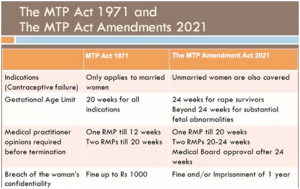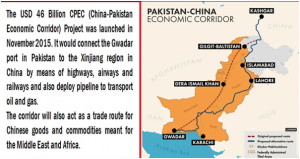THE INDIAN POLITY AND GOVERNANCE
1.HOW WILL SC RULING ON ABORTION IMPACT WOMEN?
THE CONTEXT: Recently, the Supreme Court of India allowed an unmarried woman to end her pregnancy at 24 weeks, after the Delhi High Court refused to allow it, citing the provisions of the Medical Termination of Pregnancy (MTP) Act.
THE EXPLANATION:
The top court said if a medical board assessed that the pregnancy could be terminated without any harm to the mother, then she could go ahead and have an abortion.
What is the case?
• The 25-year-old unmarried woman came to the Supreme Court on appeal after the Delhi High Court turned down her plea to allow her to have a medical termination of her pregnancy because the terms of her relationship with her partner had changed.
What was the Delhi High Court’s position?
• The Delhi High Court had taken the view that she was unmarried and since the Medical Termination of Pregnancy Act allowed only married women to terminate the pregnancy after 20 weeks, she would not be eligible to get an abortion. The Court said it would amount to killing the foetus, since she was in the 23rd week of her pregnancy. “As of today, Rule 3B of the Medical Termination of Pregnancy Rules, 2003 stands, and this court, while exercising its power under Article 226 of the Constitution of India, 1950, cannot go beyond the statute.
• The MTP Act which was amended in 2021 has the word partner instead of husband, exhibiting the intention of the law of the land to not confine it to only marital relationships. The judges said that the petitioner cannot be denied the benefit of the law, on the ground that she was unmarried, and that doing so would be contrary to the ‘object and spirit’ of the legislation.
What lies ahead?
• As per the MTP Act, all women are allowed to get a medical termination of pregnancy before 20 weeks. But only certain categories of women are allowed to have an abortion between 20 and 24 weeks — survivors of rape, minors, and a married woman whose relationship status has altered during this period.
• The Supreme Court’s expansion of the law to include unmarried women as part of the MTP Act has given women in similar circumstances an option now to access healthcare services without having to travel the long legal route to the top court every time.
• The Supreme Court of India allowed an unmarried woman to end her pregnancy at 24 weeks, after the Delhi High Court refused to allow it, citing the provisions of the Medical Termination of Pregnancy (MTP) Act.
VALUE ADDITION:
Medical Termination of Pregnancy (Amendment) Act, 2021:

Time limit and grounds for terminating a pregnancy: The Act specifies the grounds for terminating a pregnancy and specifies the time limit for terminating a pregnancy. The Bill amends these provisions.
• Termination due to failure of contraceptive method or device: Under the Act, a pregnancy may be terminated up to 20 weeks by a married woman in the case of failure of contraceptive method or device. The Bill allows unmarried women to also terminate a pregnancy for this reason.
• Medical Boards: All state and union territory governments will constitute a Medical Board. The Board will decide if pregnancy may be terminated after 24 weeks due to substantial foetal abnormalities. Each Board will have a gynaecologist, paediatrician, radiologist/sonologist, and other members notified by the state government.
• Privacy: A registered medical practitioner may only reveal the details of a woman whose pregnancy has been terminated to a person authorised by law. Violation is punishable with imprisonment up to a year, a fine, or both.
THE HEALTH ISSUES
2. WHO CLASSIFIES MONKEYPOX AS ‘PUBLIC HEALTH EMERGENCY’
THE CONTEXT: The World Health Organisation has declared the global monkeypox outbreak a ‘public health emergency of international concern’ (PHEIC), one step below that of a ‘pandemic.’
THE EXPLANATION:
• A PHEIC, according to the WHO, constitutes “…an extraordinary event, which constitutes a public health risk to other States through the international spread, and which potentially requires a coordinated international response.”
• On January 30, 2020, the organisation had categorised COVID-19 as a PHEIC, when about 7,500 cases of novel coronavirus were reported. On March 11 that year, the agency elevated it to ‘pandemic.’
• Recently, the International Health Regulations Emergency Committee to discuss the monkeypox outbreak in several countries. It is this Committee of the WHO that decides on the seriousness of a public health crisis.
Guidelines to follow
• As part of the PHEIC declaration which is said to be “temporary” and reviewed every three months, countries are expected to follow guidelines.
• They are grouped into three categories: those with no reported cases or where the last case was from 21 days ago; those with recently imported cases and experiencing human-to-human transmission and finally, countries where cases are being reported and have a history of the presence of the virus.
• The guidelines direct countries to step up surveillance, spread awareness on the pandemic, and ensure that at-risk groups aren’t stigmatised.
• The WHO said that so far 14,533 probable and laboratory-confirmed cases (including 3 deaths in Nigeria and 2 in the Central African Republic) have been reported to WHO from 72 countries across six WHO regions; up from 3,040 cases in 47 countries at the beginning of May 2022.
• The majority of reported cases of monkeypox currently are in males, and most of these cases occur among males who identified themselves as gay, bisexual and other men who have sex with men (MSM), in urban areas, and are clustered in social and sexual networks. Early reports of children affected include a few with no known epidemiological link to other cases, the WHO stated.
VALUE ADDITION:
Monkeypox
Monkeypox is a viral zoonotic disease with symptoms similar to smallpox, although with less clinical severity. The CDC’s monkeypox overview says the infection was first discovered in 1958 following two outbreaks of a pox-like disease in colonies of monkeys kept for research — which led to the name ‘monkeypox’.
How it spread?
Monkeypox spreads in different ways. The virus can spread from person-to-person through:
• direct contact with the infectious rash, scabs, or body fluids
• respiratory secretions during prolonged, face-to-face contact, or during intimate physical contact, such as kissing, cuddling, or sex
• touching items (such as clothing or linens) that previously touched the infectious rash or body fluids
• pregnant people can spread the virus to their fetus through the placenta
What are the key symptoms of monkeypox?
• According to the US Centers for Disease Control and Prevention (CDC), monkeypox begins with a fever, headache, muscle aches, back ache, and exhaustion. It also causes the lymph nodes to swell (lymphadenopathy), which smallpox does not.
• The World Health Organisation underlines that it is important not to confuse monkeypox with chickenpox, measles, bacterial skin infections, scabies, syphilis and medication-associated allergies.
What is the treatment?
• There is no proven treatment for monkeypox yet. The WHO recommends supportive treatment depending on the symptoms. Those infected are advised to isolate immediately.
• According to the Ministry of Health guidelines on supportive management of monkeypox, skin rashes should be cleaned with simple antiseptic, and covered with light dressing in case of extensive lesions. Oral ulcers should be managed with warm saline gargles
• Doctors say monkeypox is a very well-understood condition that can be managed efficiently with available clinical remedies.
THE INTERNATIONAL RELATIONS
3. OTHER COUNTRIES CAN JOIN CPEC FOR MUTUAL BENEFITS: CHINA, PAK.
THE CONTEXT: Recently, Pakistan and China decided to welcome any third country joining the multi-billion dollar China-Pakistan Economic Corridor (CPEC) for “mutual beneficial cooperation”.
THE EXPLANATION:
• The third meeting of the China-Pakistan Economic Corridor (CPEC) Joint Working Group (JWG) on International Cooperation and Coordination (JWG-ICC) was held in virtual mode. During the meeting, both sides reviewed continued implementation of CPEC and its expansion to jointly agreed priority areas.
• It was noted that as a flagship of the Belt and Road Initiative (BRI), CPEC had broken new ground in strengthening international and regional connectivity, especially in the context of its extension to Afghanistan.
• It was also agreed that CPEC’s development had reached a new point, with increasing emphasis on high-quality development of industry, agriculture, IT, and science and technology, while ensuring tangible socio-economic benefits for the people.
• According to the sources, “the timely completion of CPEC projects and steady progress on realising important projects in the pipeline was energising bilateral cooperation and further strengthening the foundation for Pakistan’s economic modernisation and enhancing the capacity for sustained progress and prosperity”.
VALUE ADDITION:
• CPEC (China-Pakistan Economic Corridor) is clutch of projects valued at $51 billion project which aims at rapidly expanding and upgrading Pakistan’s infrastructure and strengthening the economic ties between the People’s Republic of China (China) and Pakistan. It includes building roads, laying railway lines and pipelines to carry oil and gas.
• CPEC eventually aims at linking the city of Gwadar in South Western Pakistan to China’s North Western region Xinjiang through a vast network of highways and railways.
• The proposed project will be financed by heavily-subsidised loans, that will be disbursed to the Government of Pakistan by Chinese banking giants such as Exim Bank of China, China Development Bank, and the Industrial and Commercial Bank of China.
• The ‘China-Pakistan Economic Corridor’ violates India’s sovereignty and territorial integrity. India’s principal objection was that CPEC passed through Pakistan-occupied Kashmir (PoK)

THE ENVIRONMENT, ECOLOGY AND CLIMATE CHANGE
4. ‘BAT HABITATS IN SOUTH WESTERN GHATS LIE PREDOMINANTLY OUTSIDE PROTECTED AREAS’
THE CONTEXT: A recent study indicates that more than 50% of habitats suitable for 37 species of bats in the Southern Western Ghats lie outside protected areas, potentially increasing threats faced by the animals due to poaching for their meat, habitat loss and stigma from local communities, especially after the COVID-19 pandemic.
THE EXPLANATION:
• The study area around 1,600 km of the Southern Western Ghats, encompassing biodiverse regions in Kerala, Karnataka and Tamil Nadu. Six major biodiversity hotspots— Agastyamalai, Periyar Tiger Reserve, Anamalai, the Nilgiris, the Wayanad-Mudumalai complex and Brahmagiri— were part of the study area.
• According to the researchers, the Southern Western Ghats was home to rare and endangered bat species such as Salim Ali’s fruit bat (Latidenssalimalii) and the Pomona roundleaf bat (Hipposiderospomona).
• “Different species had different percentages of their ranges protected: five had less than 10% protection; six had between 10% and 20% protection; 10 had between 20% and 30% protection; 14 had between 30% and 40% protection; and two had between 40% and 50% protection. Moreover, potential suitable areas of forest-dependent species were mostly found to be in unprotected areas,” the researchers noted.
• “The study will hopefully help local governments and forest departments come up with conservation plans to protect bat species across the Western Ghats”.
Rising threats
• Researchers also noted that threats to bat species were increasing. “While bats like the Salim Ali’s fruit bat continued to be hunted for their meat, there have also been reports of people’s attitudes towards bats deteriorating since the COVID-19 pandemic due to misplaced concerns of having bat colonies near human settlements.
• People are increasingly coming to believe that the chances of them contracting zoonotic diseases increases due to presence of bats near their houses. Identifying these populations of bats outside protected areas could help forest conservation authorities spread awareness among human communities on the importance of bats to ecology and the environment”.
THE SCIENCE AND TECHNOLOGY
5. KERALA RESEARCHERS DETECT FUNGAL DISEASE IN JACKFRUIT
THE CONTEXT: Recently, the researchers at the Integrated Farming Systems Research Station (IFSRS), a Kerala Agricultural University (KAU) have reported the emergence of a new fungal disease in jackfruit.
THE EXPLANATION:
• It is perhaps the first time that fruit rot caused by the fungus Atheliarolfsii is being reported in jackfruit (Artocarpus heterophyllus) in India, according to a researcher’s IFSRS.
• A soil-borne fungal pathogen, Atheliarolfsii is a major threat to several crops and, hence, the new development warrants immediate attention, a research paper describing the IFSRS findings published in the latest edition of the Journal of Plant Pathology warned.
• The disease-infected samples were of mature jackfruit collected from Thiruvananthapuram, Kottayam and Pathanamthitta districts. While fruit varieties introduced from elsewhere can bring new diseases with them, the fruit rot caused by Atheliarolfsii does not fall into this category.
• “Atheliarolfsii with a wide host range which attacks various commercially cultivated crops belonging to different families. But this is the first time it is being reported in jackfruit in the country. One disease which is found in immature jackfruit is the Rhizopus fruit rot, but it does not affect mature fruit, “a researcher highlighted.
THE PRELIMS PERSPECTIVE
6. HENLEY PASSPORT INDEX 2022
THE CONTEXT:Japan has the world’s most powerful passport, followed by Singapore and South Korea, as per Henley Passport Index 2022. The holder of Japanese passport will get visa-free access to 193 countries. India has slipped from 85th place to the 87th with visa-free access to 60 countries.
THE EXPLANATION:
Performance of the countries in index:
• Among the 199 countries, Japan was ranked first. It is followed by Singapore and South Korea.
• These three countries have reversed the pre-covid-19 pandemic rankings, in which European nations were dominating.
• Japan’s passport provides entry to 193 countries without prior visa. On the other hand, Singapore and South Korea allows hassle-free entry to 192 countries.
• Top 10 countries in World’s most powerful passports list include-Japan, Singapore, South Korea, Germany, Spain, Finland, Italy, Luxemburg, Austria and Denmark (in the order).
• European nations, US and UK are among other top-ranked countries.
• Passport holders from Afghanistan have access to just 27 countries. On the other hand, Iraqi passport provide hassle free entry to 29 countries. These two countries have been ranked at lowest position.
Performance of India and its neighbour:
• Among Asian countries, India, Mauritius and Tajikistan share the 87th position, with hassle-free entry to 67 countries, without prior visa.
• China and Bolivia are ranked at 69th Their passports allow access to 80 destinations.
• Bangladesh is at 104th position.
• Pakistan has the fourth worst passport worldwide, with access to 32 destinations.
VALUE ADDITION:
What is Henley Passport Index?
• The Henley Passport Index is the original ranking of all the world’s passports according to the number of destinations their holders can access without a prior visa.
• Originally created by Dr Christian H. Kaelin (chairman of Henley & Partners), the ranking is based on exclusive data from the International Air Transport Association (IATA), which maintains the world’s largest and most accurate database of travel information.
• It was launched in 2006 and includes 199 different passports.
• The Henley Passport Index comes when countries are easing travel rules for international visitors after almost two years since the onset of the Covid-19 pandemic.
• The index ranks countries’ passports according to the number of destinations their holders can visit without a prior visa. The rankings are based on the analysis of the International Air Transport Association (IATA) data.

